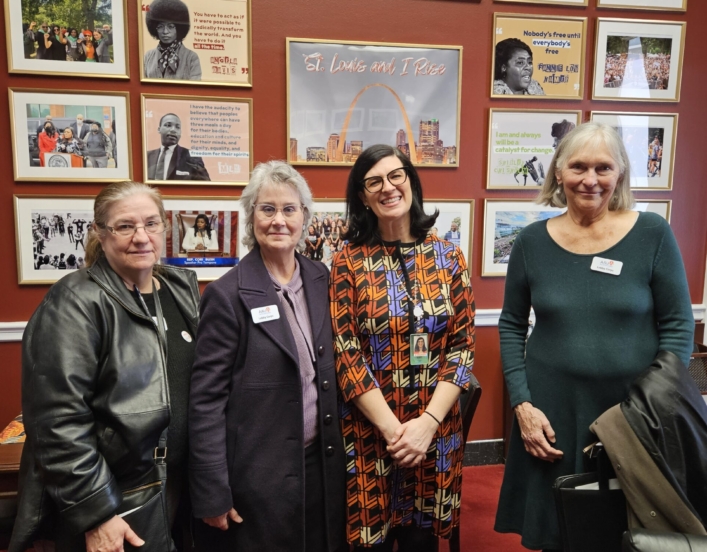AAUW President Mary Purcell’s First Hand Account of the 1995 Beijing U.N. Fourth Conference on Women

Mary Purcell represented AAUW as an accredited observer at the U.N. Fourth Conference on Women in 1995 – as former AAUW president and United Nations representative to the Untied Nations.
From August 30 to September 16, the eyes of the world were on China, where thousands of women gathered to attend one or both of two significant events: The 1995 NGO Forum on Women and the U.N. Fourth World Conference on Women. For many the road to China was very difficult, marked by months of struggling to obtain funds and visas, but the 31,000 women from 200 countries who attended the nongovernmental organization forum were compelled by the need to join the fast-growing, worldwide network of women determined to achieve equality, development, and peace.
Opening Discussions at the NGO Forum
In spite of the inconvenience of being farmed out to Huairou — 45 minutes by bus from Beijing and the official U.N. conference — participants feasted for 10 days on a smorgasbord of some 5,000 events, including workshops, plenaries, training sessions, exhibitions, and special cultural programs. Between events, women of all ages shared ideas and experiences and voiced their views on global issues affecting women and girls as they gathered in regional (North America, Europe, Africa, Asia, etc.) or theme (peace, youth, older women, disabled, etc.) tents or beneath colorful umbrellas.
Although they spoke in many languages, the women had one goal in mind — to advance the status of women by the year 2000. Rain, deflated tents, stiflingly hot rooms, and excessive numbers of security guards did not deter them. Their spirits never flagged, and they left Huairou more determined than ever to change the world.
Creating a Conference Action Plan
As the NGO forum came to glorious closure, the official U.N. conference got underway at the modern Beijing International Conference Center. More than 12,000 attended, of whom 5,000 were official delegates, 3,245 were press members, and 4,030 were representatives of NGOs. A major issue that was never satisfactorily settled was the lack of adequate access for disabled women. This unacceptable and demeaning situation must be addressed by the United Nations before the Habitat II conference in June 1996. The many well-organized issue-oriented caucuses — focusing on such areas as environment, disabled women, indigenous women, girls, human rights, and reproductive rights/health — added strength and a new dimension to NGO participation in U.N. conferences.
The major work of the conference was transforming a draft plan for action — the result of two-and-a-half years of preparation — into final, acceptable form. AAUW was a contributor to the writing of the United States’ national report, and our input was sought by the delegation in regard to the section on education in the platform. The sections of the document on which there was no consensus during the preparatory process were placed in brackets to be considered at the conference.
The Platform for Action document, as it arrived in Beijing, was more than 30 percent bracketed, a rather discouraging note on which to begin since, for final consideration by the delegates, the platform had to be completely free of brackets. Many of the most controversial issues related to health, human rights, parental rights in relation to children’s rights, and inheritance rights. But the delegates were more than equal to the task.
During the second week they met in smaller subgroups almost around the clock to find compromise language that would allow consensus. NGO representatives did all in their power behind the scenes to assist in the process.
It was with a real sense of achievement that the chair of the main committee, Patricia Licuanan, presented a bracket-free document to the conference on the final day. Its adoption by consensus was indeed a major accomplishment. As Bella Abzug declared afterward, “Imperfect though it may be, the platform is the strongest consensus on women’s equality, empowerment, and justice ever produced by the world’s governments.”
Putting the Plan into Action
Now one must ask, What does it all mean in reality? The platform is not a legally binding document, but rather a guide for the U.N. governments and nongovernmental organizations. It clearly recognizes women’s rights as human rights; the right of women to make their own decisions about childbearing and sexuality without fear of coercion; women’s rights to protection against all forms of violence including rape, genital mutilation, domestic abuse, and sexual harassment; the rights of the child, balanced by the responsibilities of the parents, with the best interest of the child paramount. For those who worked so hard on the Caucus on Girls, there is great satisfaction in seeing the “persistent discrimination against and violation of the rights of the girl child” included as a separate critical area of concern where such issues as child marriage, female infanticide, and prenatal sex selection are addressed.
It is true that prior women’s conferences produced well-meaning documents that did not significantly change things. This time there is a difference. The NGO community welcomed and heartily supported Australia’s proposal that all governments make specific commitments for implementation before leaving Beijing, and 68 countries accepted the challenge. The United States, for example, announced a six-year, $1.6 billion anti-violence program.
In addition to those governments that made specific commitments, more governments will announce theirs shortly. The platform contains passages setting out implementation strategy timetables, and it encourages women’s organizations and feminist groups to work with other NGOs in advocating implementation of the Platform for Action by governments and regional international bodies.
It will be up to NGOs such as AAUW to keep track of these governmental plans of action, to make sure that NGOs are indeed part of the process. Remember, this time we have a scorecard, and we must use it.

